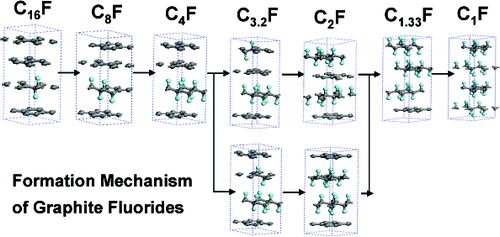Unraveling Structural Models of Graphite Fluorides by Density Functional Theory Calculations
슈퍼관리자
2021-05-21
Unraveling Structural Models of Graphite Fluorides by Density Functional Theory Calculations
-
Authors :
S. S. Han, T. H. Yu, B. Merinov, A. C. T. van Duin, R. Yazami, and W. A. Goddard III
-
Journal :
Chemistry of Materials
-
Vol :
22
-
Page :
2142-2154
-
Year :
2010

Abstract
Using density functional theory (DFT) calculations, we have studied structural models of graphite fluorides for five fluorine compositions; C1F (CF1), C2F (CF0.5), C3F (CF0.33), C4F (CF0.25), and C16F (CF0.0625). For each composition, we considered several possible structural models and calculated heat of formation relative to the pristine graphite and F2 molecule. We also simulated X-ray diffraction patterns for each structural model and compared those with experiments. We find, in agreement with earlier experiments, that the most stable structure of the C1F (CF1) has an infinite array of trans-linked cyclohexane chairs of covalent C−F bonds (1.38 Å). We also find that the effects of the layer stacking sequence such as AB or AA′ is not significant. For the C2F (CF0.5) system, an earlier model in the literature indicated that all carbon atoms have only sp3 hybridization due to coexistence of C−C and C−F covalent bonds. However, in this work, we propose a new C2F (CF0.5) crystal structure in which half of the carbon atoms has sp3 hybridization due to C−F covalent bonds and the other half has sp2 hybridization as found in pristine graphite. Besides, with the structural models of graphite fluorides considered in this work, their formation mechanism is also clarified. Initially, two fluorines are positioned at adjacent carbon atoms with the trans geometry, and then, one graphene layer is fully covered with fluorine while other layers are still pristine. After full coverage of the graphene layer, newly added fluorine will get located on this pristine graphene layer, and then, finally, all carbon layers are covered with fluorine leading to formation of C1F crystal. Through this mechanism, we can explain phase transition from the C2F to the C1F through further fluorination, which was demonstrated by an earlier experiment.















